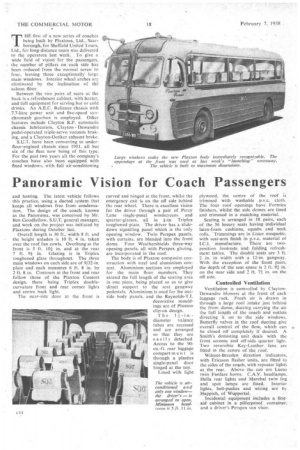Panoramic Vision for Coach Passengers
Page 62

If you've noticed an error in this article please click here to report it so we can fix it.
T. . HE first of a new series of coaches '• being built by Plaxtons, Ltd., Scarborough, for Sheffield United Tours, Lid., for long-distance tours Was delivered to the operators last Week; To give a wide field of vision for the .passengers, the number of pillars on each side has been reduced from the normal seven. to four, leaving three exceptionally large main :windows. Interior wheel arches are eliminated by the inclination of the
saloon flOor. .
Between the two, pairs of seats at the back is a refreshment cabinet, with heater, and full equipment for serving hot or cold drinks. An A.E.C. Reliance chassis with 7.7-litre power unit and five-speed synchromesh gearbox is employed. Other features include Clayton R.P. automatic chassis lubrication, Clayton Dewandre pedal-operated triple-servo vacuum braking, and a Clayton-Octiker exhaust brake.
S.U.T. hav.e been converting to underfloor-engined chassis since 1951, all but six of the fleet now being of this type. For the past two years all the company's coaches have also been equipped with fixed windows, with full air-conditioning and heating. The latest vehicle follows this practice, using a dueled system that keeps all windows free from condensation. The design of the coach, known as the Panorama, was conceived by Mr. Ben Goodfellow, S.U.T. general manager, and work on the project was initiated by Plaxtorss during October fast.
Overall length is 30 ft., width 8 ft. and the height unladen is 10 ft. 4 in. taken over the roof fan cowls. Overhang at the front is 5 ft. 10i. in and at the rear 7 ft. 9f in. Glazing is in Triplex toughened glass throughout. The three main windows on each side are of 9/32-in. plate and each measures 6 ft, S in. by 2 ft. 8 in. Contours at the front and rear follow those of the Plaxton Consort design, there being Triplex doublecurvature front and rear corner lights and centre hack light.
The near-side door at the front is curved and hinged at the front, whilst the emergency exit is on the off side behind the rear wheel. There is excellent vision for the driver through a pair of Percy Lane single-panel windscreens and quarter-glasses, all in fin. Triplex toughened plate. The driver has a slidedown signalling panel which is the only opening window, Twin Perspex panels, with curtains, are blended into the front dome. Four Weathershields three-way opening panels. all with Perspex glazing, are incorporated in the roof.
The body is of Plaxton composite construction with steel and aluminium content. Aluminium sections are employed for the main floor members. They extend the full length of the seating area in one piece, being placed so as to give direct support to the seat gangway pedestals. Aluminium is used for the outside body panels, and the Reynolds-T.I. decorative mouldings are of Plaxton clip-on design.
The 1 1-in.diameter valance tubes are recessed and are arranged so that they are easily detached Access to the 90cu-ft. rear luggage compart men t is through a plastics single-panel door hinged at the top.
Lined with light plywood. the centre of the roof is trimmed with washable p.v.c. cloth. The four roof openings have Formica finishers, whilst the side domes are lined and trimmed in a matching material.
Seating is arranged in 18 pairs, each of the 36 luxury seats having individual latex-foam cushions, squabs and neck rolls. Trimmings are in Lister moquette, with seat-arm finish in p.v.c. material of
manufacture. There are twoposition footrests and folding refreshment tables. The double seats are 3 ft. 2 in. its width witha 12-in. gangway. With the exception of the front pairs, the depth of the seat space. is 2 ft. 91 in. on the near side and 2 ft. n in. on the off side.
Controlled Ventilation
Ventilation is controlled by ClaytonDewandre blowers at the front of each luggage rack. Fresh air is drawn in through a large roof intake just behind the front dome, ducting carrying the air the full length Of the coach and outlets directing it on to the side windows. Butterfly valves in the roof ducting give overall control of the flow, which can be closed off completely if desired. A Smith's demisting unit deals with the front screens and off-side quarter light. Two reversible Key-Leather fans are fitted in the centre of the roof.
Wilmot-Breeden direction indicators, with Ericsson flasher units, are fitted to the sides of the coach, with repeater iighm at the rear. Above the cab arc Lucas twin Fanfare horns. C.A.V. headlamps, Hella rear lights and Marchal twin fog and spot lamps are fitted. Interior lights, bell-pushes and wiring are by Happich, of Wuppertal.
Incidental equipment includes a firstaid cabinet in a pilferproof container, and a driver's Perspex sun visor.
































































































































